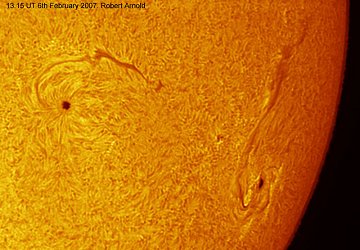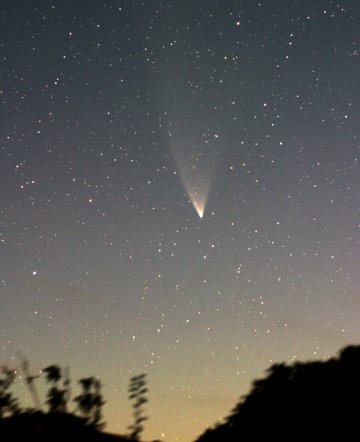 Did you sleep through the auroras of Dec. 14th? Next time get a wake-up call: Spaceweather PHONE.
Did you sleep through the auroras of Dec. 14th? Next time get a wake-up call: Spaceweather PHONE.
EVENING PLANETS: When the sun sets tonight, go outside and look west. You'll see Venus and Mercury beaming through the glow of sunset. This is a great week to enjoy the two planets together. Mercury reaches its maximum elongation (apparent distance) from the sun on Feb. 7th, making it unusually easy to see and a charming companion for always-bright Venus: finder chart.
DOUBLE SPIRAL: Got a solar telescope? Point it at the sun today. Two of the strangest spiral sunspots are heading for the western limb where they will soon disappear. Hours ago on the Isle of Skye, Scotland, Robert Arnold took this picture:

The spirals are filaments of relatively cool gas emerging from the sunspots' cores. Astrophotographer Gary Palmer calls them "liquid filaments" because they are in constant motion. Catch them before they go!
more images: from Pete Lawrence of Selsey, West Sussex, UK; from Emiel Veldhuis of Zwolle, the Netherlands; from Peter Paice of Belfast, Northern Ireland.
COMET MCNAUGHT: Now that the full Moon is out of the way, observers in the Southern Hemisphere are spotting Comet McNaught again. Last night, "it was visible to the unaided eye," says Chris Picking of Wairarapa, New Zealand. A 3-minute exposure on his off-the-shelf digital camera produced this image:

Photo details: Canon 10D, 50mm lens, f3.5, 3 minute exposure
Current estimates of the comet's brightness place it between 3rd and 4th magnitude. That's about 2500 times dimmer than it was at maximum in mid-January. Ironically, as the comet fades it becomes an easier target for sensitive telescopes, and some interesting things are coming to light: A team of astronomers using the ESO's 3.5-meter New Technology Telescope in Chile have just announced their discovery of "strong spiral jets extending at least 32,000 km from the comet's nucleus." [Ref: C. Snodgrass et al., IAU Electronic Telegram 832.] Stay tuned for updates.
Comet McNaught Photo Gallery
[finder chart] [ephemeris] [comet camera]

